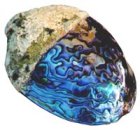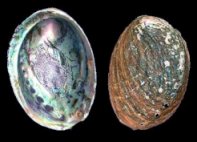
 Paua is a species of abalone.
Paua is a species of abalone.It is only found in the sea around the coasts of New Zealand.
This marine mollusc eats seaweed and lives by clinging onto rocks at depths of around 1-10 metres or 3- 30ft, normally along the
shoreline. I have often encountered hundreds of these shellfish
growing on top of each other often up to three deep in only a few
feet of water. (though you have to travel and look for these places
).
The Paua ranges in size from 7-14cm or 2.5-5in at maturity, but can grow to a maximum of around 18cm or 8in.
There are two types of paua, one the smaller of the two is the yellow foot ( this has a distinct yellow - orangey colourd foot) and the other being the normal every day black foot paua.
The Paua Shell is the most colourful of all the abalone shells. Most other abalone are pale and drab in comparison. There is no other shell in the world that has the colour like the Paua Shell. Colour that varies from greens & pinks to purples & blues and even some shells with gold or crimson toning.
The colour in the paua shell can change when viewed at different angles. This iridescence is similar to that of Mother of Pearl shell found over seas but far more brilliant, is what makes paua shell so amazing as a gem material for use in jewellery. It is really one of nature's marvels. Each shell is different in it's colour toning, and in the patterns within the shell.
The black patterns in the shell come from layers of protein that
are laid down between the layers of calcium that make up the shell.

The brilliant colours are from light being refracted within the crystal layers. The same effect that the iridescent colour found in Opals.
Paua grow larger in the cool South Island waters than they do in the warmer northern waters. Consequently most paua are harvested from the South mainly from the Chatham and Stewart Islands and from the North Islandís southern coastline.
Commercial Fishery:
The commercial fishery for paua dates from the mid-1940s, when the shell was sold on the market and the meat generally discarded.
Both meat and shell were sold from the late 1950s.
Fishers gather paua by hand while free diving (use of underwater
breathing apparatus is not permitted). Most of the catch is from the
Wairarapa coast southwards: the major fishing areas are in the South
Island, Stewart Island and the Chatham Islands.
Virtually the entire commercial fishery is for the black-footed
paua, with a minimum legal size for harvesting of 125 mm shell
length.
The yellow-footed paua, is less abundant and is caught only
in small quantities, it has a minimum legal size of 80 mm.